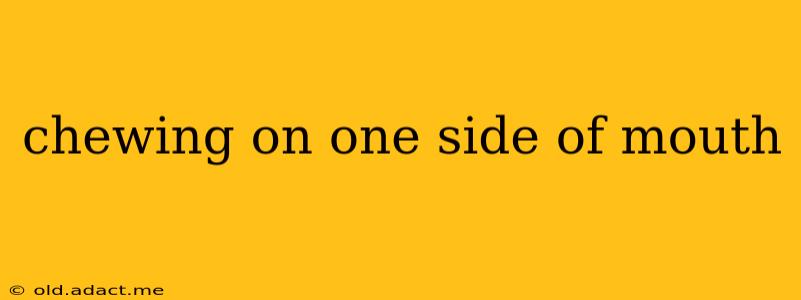Chewing predominantly on one side of your mouth is a common habit that many people experience without ever giving it a second thought. However, persistent unilateral chewing can sometimes indicate underlying dental or medical issues. This comprehensive guide explores the various reasons why you might favor one side, the potential problems it can cause, and steps you can take to address this habit.
Why Do I Chew on One Side of My Mouth?
This question often tops the list of concerns. The reasons are multifaceted, ranging from simple habits to more complex dental problems.
-
Habit: This is often the most straightforward explanation. Like many habits, it may have started unconsciously and become ingrained over time. Perhaps you developed a preference as a child, or it's simply more comfortable.
-
Dental Issues: A misaligned bite (malocclusion), missing teeth, poorly fitting dentures, or painful teeth or fillings on one side of the mouth can make chewing on that side uncomfortable, forcing you to favor the other. Similarly, temporomandibular joint (TMJ) disorders can cause jaw pain that limits your ability to chew efficiently on one side.
-
Muscle Imbalance: Over time, consistently chewing on one side can lead to muscle imbalances in the jaw. The muscles on the dominant side become stronger and more developed, while those on the other side can weaken, making it feel less comfortable or efficient to chew on the neglected side.
-
Oral Ulcers or Mouth Sores: A canker sore or other irritation on one side of the mouth will naturally make chewing on that side uncomfortable and lead to a preference for the unaffected side.
-
Wisdom Teeth: Impacted or partially erupted wisdom teeth can cause pain and discomfort, leading to unilateral chewing.
Is Chewing on One Side of My Mouth Bad?
While occasional unilateral chewing is usually harmless, persistent one-sided chewing can lead to several problems:
-
TMJ Disorders: Chronic one-sided chewing puts increased strain on the temporomandibular joint and its associated muscles, potentially leading to TMJ disorders characterized by jaw pain, clicking, and limited movement.
-
Facial Asymmetry: Over time, the stronger muscles on one side of the face can lead to asymmetry, causing one side of the face to appear more developed or prominent than the other.
-
Dental Problems: Increased wear and tear on the teeth on the dominant side can lead to uneven tooth wear, potential chipping, and increased risk of dental problems.
-
Headaches: TMJ disorders often lead to headaches, which can be worsened by persistent one-sided chewing.
How Can I Stop Chewing on One Side of My Mouth?
Breaking this habit requires conscious effort and potentially professional intervention. Here's a multi-pronged approach:
-
Become Aware: Pay attention to your chewing habits throughout the day. Notice when you instinctively reach for one side.
-
Consciously Switch Sides: Make a conscious effort to chew on the opposite side. Start with small, manageable changes.
-
Practice Regularly: Regular practice is key to establishing a new habit. Set reminders throughout the day.
-
Address Underlying Dental Issues: If you suspect dental issues are contributing to the habit, consult a dentist or orthodontist for evaluation and treatment. This may include addressing malocclusion, replacing missing teeth, or correcting other dental problems.
-
Massage and Exercises: Gentle massage of the jaw muscles and targeted exercises can help to strengthen weaker muscles and improve balance.
-
Seek Professional Help: If the habit persists despite your efforts, consider consulting a physiotherapist or occupational therapist experienced in TMJ disorders. They can provide personalized advice and treatment options.
What If My Jaw Hurts When I Try to Chew on the Other Side?
Jaw pain when chewing on the non-dominant side could indicate an underlying issue such as TMJ disorder or muscle imbalance. In this case, it's crucial to consult a dentist or other healthcare professional for diagnosis and treatment. Self-treating could potentially worsen the problem.
How Can I Tell If My Chewing Habit Is Causing a Problem?
Pay attention to symptoms such as persistent jaw pain, clicking or popping in the jaw, headaches, facial asymmetry, or uneven tooth wear. If you experience any of these symptoms, seek professional help for evaluation and diagnosis.
By understanding the causes and potential consequences of chewing on one side of your mouth and implementing the suggested strategies, you can address this habit and improve your overall oral health and well-being. Remember that consistent effort is key, and professional guidance is often beneficial.
